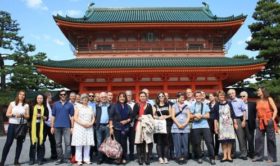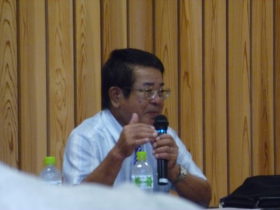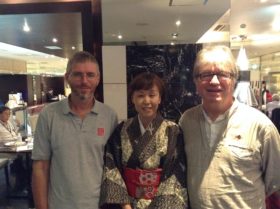Friday 3rd October

The group overall is made up of 3 Brazilians, 2 Canadians, 2 South Koreans, 4 Americans, 4 Welsh, 1 Scottish, 1 English, 2 Swedish, 3 French, 2 Italians, 8 Swiss, and our 2 Japanese guides / translators. For the morning we were split into two groups – the politicians (English Labour MEP, Brazilian Mayor, Canadian MP, Swiss National Councillor) and five journalists (American, Scottish, Swedish, and two South Korean) had meetings with Japanese politicians, while the other 24 of us went on a sight-seeing coach tour of Tokyo.
We drove round part of the Emperor’s Palace grounds, which are only open to the public on two days a year; the circuit around the grounds is apparently a very popular jogging circuit. We were told lots about the Emperor and his family, which was of course of great interest to me and most of the rest of the group! The grounds are effectively an island in a lake within the city, and it’s all grassed and planted with evergreen trees, as green is traditionally associated with being everlasting. There are no flowers at all – as they wither and die (unlike the Emperor).
We were also told a little about Japan’s two main religions, Buddhism and Shinto-ism:
Shinto – a purely Japanese religion, with lots of gods but no representation of gods at their shrines;
Buddhism – an imported religion, with figures of their gods at their temples.
Most Japanese people apparently follow both religions, with small shrines for each religion at different parts of their homes. Shinto is largely used to celebrate births and other life-positive events, whereas Buddhism is turned to when there are deaths (perhaps due to its promise of reincarnation). Formerly it was quite common to have both religions within the same temples – but apparently Western visitors couldn’t comprehend such co-existence, and so since 1850-ish the religions have tended to be set apart – even if only separate within the same grounds.
We visited the Kaminarimon Gate, Asakusa temple, where people inhaled holy smoke to cure their illnesses (soon to be available on the NHS ?), and had their fortunes foretold – if it’s bad, they are tied onto a frame at a special prayer area, so that the bad luck stays there, and can be dissipated by the holy temple. The souvenir shops were certainly enjoying good luck !
Apart from the “showcase” palace, temples, shrines, and a few government buildings, I saw nothing in Tokyo that suggested character other than “just” being a big city. Almost the entire city was destroyed by firebombing in 1945, of course, but the high rise blocks that have replaced the ruined city are all basically utilitarian and ugly.
Lunch in Tokyo was at a contemporary Japanese restaurant, which was all very stylish, with lots of marble and clean lines, with every detail perfect. The veggie option was salad, bread, grilled vegetables, and fruit – all very tasty and very filling.
At 2pm we got back on the coach, picked up the other group, and set off for Koriyama, 200km NE of Tokyo. After that we had lunch on a nice comfortable coach, with the sun streaming in through the window; I settled down for a snooze – only for our tour leaders to announce that we would be having a talk on the bus by Maria Vitagliano about Green cross’ social programmes in Fukushima (in German with translation into English). I quickly perked up (after a moment’s disbelief) and heard that there were three strands to their social programme – before being woken up by the applause at the end of the presentation! I was pleased to note that I wasn’t the only jet-lagged person to sleep through it !
The countryside outside Tokyo was mostly very flat, with almost all the land growing crops, interspersed with the occasional wooded hill. Despite the flatness, all the rivers seemed to be very fast flowing – although in many cases, as only a 10-20m river in perhaps a 100-200m riverbed. A lot of these would have had hydro plants upstream. Apart from a few ducks, I saw only one “herd” of about 10 cows. There were more solar panels out of the city, but still quite patchy; in one 15 minute period, I only saw 4 sets, but then there were 16 installations in the following 5 minutes.

At 5.45pm we stopped at the Myukaru-Gakuto-Ken conference centre, for an hour’s talk and Q & A session with Mr Yukiteru Naka. He had worked for General Electric on their Boiling Water Reactors (BWRs) in the USA for 14 years, and was later a service engineer for GE at Fukushima. His job since the accident has been to try to bring the situation under control, as the manager of a small company contracted to work on the reactors.
He first outlined how a reactor works: the nuclear reaction is fed and controlled by radioactive fuel rods, which can be moved in or out of the reactor core to control the nuclear reaction, which produces heat to boil the water to create the steam which drives the generators. The reactor is inside the primary containment vessel, which also gets hot during the nuclear reaction, and so has to be cooled by circulating water. All this is within a building, with two floors above for the control room, etc.
The fuel rods eventually wear out of course, becoming “spent”, although they are still highly radioactive but not of a form where they can be used in the reactor. The spent fuel rods then have to be removed from the reactor and also kept cool, in “ponds”, with circulating water. Because they’re so dangerous, you don’t want to move them very far, so the ponds for the Fukushima reactors were in the top storey of the reactor building – makes perfect sense, what could possibly go wrong ?
The Fukushima reactors used MOX (mixed oxide) fuel, quite possibly manufactured at the Sellafield MOX complex – which Jan and I (and about 198 others) once occupied in Greenpeace action, when the MOX plant was still under construction (1996; the plant has now been closed down, and in the long – perhaps 100 year – process of decommissioning). The significance of this is that MOX fuel contains plutonium (hooray !).
I should also mention that Fukushima is a prefecture (county) within which is Fukushima City (inland), and on the coast are the Fukushima Dai-ichi and Dai-ni nuclear complexes. Fukushima Dai-ichi had 6 nuclear reactors, numbered 1 to 6, built in the 1970s with a projected 30-year lifespan, which was then extended by another 30 years. At the time of the tsunami, reactors 4 to 6 were closed down for routine maintenance, with all 1,500 of reactor 4’s fuel rods in its fuel pond on the top storey of the building; reactors 1 to 3 were all working, but with about 500 spent fuel rods in each of their fuel ponds.
11th March 2011 – earthquake and tsunami. The tsunami breaks through the sea walls and creates havoc with the pipes, controls, electricity supply, etc. All the cooling systems are destroyed. There’s an explosion in the control rooms of reactor 4. Regardless of anything else, the reactors and ponds need to be cooled, so as soon as the can be hoses and sprays are set up just blasting everything with water. This water becomes contaminated, along with the tsunami water all over the site, which has also caused overflows and leaks in all the stores which are designed to store the cooling water (when that becomes too radioactive to continue using). Simple solution: store as much radioactive water as possible, and allow the rest of the radioactive water to escape into the sea.
Main worry: if there’s another earthquake (or a powerful after-shock), the already damaged reactor 4 building could collapse, exposing the fuel rods to the atmosphere. (It’s at this point that the US authorities order the evacuation of all US nationals within 80km of the power plant). The only solution is to remove all the fuel rods – which has almost been completed 3 ½ years later.
Meanwhile, in reactors 1 to 3, some of the fuel rods have dropped through the melted reactor casing, onto the primary containment, and then melted due to the high (uncontrolled) temperatures. Radiation levels are still so high that no one can go into these reactor buildings to even see what’s going on. Main fear: if the melted fuel rods start a nuclear chain reaction, the primary containment vessel could rupture / explode, and then the radiation released would mean evacuating everything and everyone as far as Tokyo (nearly 200km).
Mr Naka believes that the post-tsunami cooling systems are now all working securely, and the three main remaining problems are:
• Getting the fuel rods out of reactors 1, 2 and 3;
• Dealing with the contaminated water;
• Full decommissioning of the site.
They have installed an ALPS water decontamination plant, but it keeps on breaking down. Furthermore, the ground water goes through the site, getting contaminated on the way – which is where the proposed ice-wall comes in: a 1,500m long, 30m deep underground “wall” around the reactors, being kept at –30 C, to block the ground water from entering the site. But the same water will then accumulate against the ice-wall, so they’ve also got to have underground pumps and pipes through which this water can be pumped away. It’s never been done before (on this scale or timescale) – it might work – but it will certainly need a lot of energy to maintain.
The questions:
• How safe are the fish to eat ? – fine if caught more than 80km away (despite some Californian tuna having to be treated as low level nuclear waste);
• How long until all the fuel rods are removed from reactors 1, 2 and 3 ? – they’re currently conducting a feasibility test, using robotic devices, to enter the reactor buildings; if these are successful, then perhaps 30 years (30 !!);
• How is workers’ safety protected ? – when they reach their safe limit, the workers have to leave the site for the rest of the year, which is causing a huge problem of the shortage of trained experienced workers (or indeed any workers);
• Is it now safe if there was another earthquake ? – to which Mr Naka just smiled and laughed.
Mr Naka was a pleasant, cheerful, practical sort of man, just “getting on with what needs to be done” given the situation. No gloss or smarm, and no dodging questions, but although he struck me as honest and competent, he did not inspire confidence that the accident was “over” !
We got back on the coach to finish our journey to Koriyama, 130km from the nuclear site, where the background radiation level is twice that of Tokyo. We had several different Geiger counters, including one fully professional version, and several people had been issued with individual dosimeters for the duration of the trip, which were then going to be analysed (I didn’t get one).
After booking in, we settled down to a meal at 8pm – only to learn that during the meal, we were to have a video presentation and two speakers. I can’t remember what we ate ! The video was quite good, and short, showing the previous Mayor of a town near Koriyama getting a Green Cross award, as his prompt and efficient evacuation had ensured that 1,600 people avoided being heavily exposed to high radiation levels on the days after the accident.
Then the Mayor of Koriyama spoke briefly – in Japanese with translation into English and German – welcoming us to Koriyama and stressing how important it is that the world remembers what happened at Fukushima and its on-going consequences. The situation was a bit surreal because we were spread between two sections of the restaurant, which meant that I (and several others) could hear but not see the speaker – and of course the rest of the restaurant was filled with people not on the study tour, who then had this additional “entertainment” during their meal.

Then Ikuko Hebiishi, female Green Party Councillor on Fukushima Prefecture Council, spoke – brilliantly! No messing about, an all-out devastating attack on nuclear power in Japan and worldwide. I jumped up at the end of the applause to go into the other section of the restaurant and get a photograph, only to find that she also fitted my stereotyped vision of a Japanese woman – diminutive and wearing a kimono! I thanked her profusely, gave her a “Ynni Niwclear ? Dim Diolch !” badge, and we then had a series of photos, including her with the Welsh contingent all holding “Wylfa-shima” posters, and agreements that they could all be used by everyone. A great end to the day.
